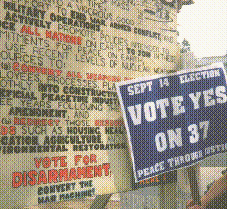
ABOUT
INITIATIVE 37
Text of Initiative 37
A Background
In the winter of l987 several peace activists began circulating a petition which began, "We human beings threatened with
nuclear genocide call upon the Congresses of the United States
and the Union of Soviet Socialist Republics to jointly amend the
constitutions of both nations."
The text was addressed to legislative leaders of both nuclear
powers. It called for the "dismantling and disabling" of all
nuclear warheads by the year 2000, and to "induce" all nations to
enter into "good faith efforts to promote peace on earth." It
also called for the hundreds of billions of dollars spent on
nuclear weapons annually in both countries to be converted
directly to "constructive peace time industries during the three
years after the ratification of this amendment" to the
constitution of both countries.
Over the next several years, many thousands of people would sign
that petition in Lafayette Park, outside the White House. For
many years Lafayette Park has been known as "Peace Park," and has
been a public forum and gathering place for individuals with deep
commitment to promoting social change.
The activists had the petition translated into several other
languages. Many volunteers carried copies of the petition to
countries all over the world, and peace groups all over the
country have reported on the progress of what has come to be
known as Proposition One.
Each year for three years a copy of the petition, along with an
update on the activists' progress, had annually been
hand-delivered to the legislative aide of each senator and
representative in Congress, advising them of the thousands of
signatures that had been obtained since the last letter and
asking that they "bring the idea to the floor for a vote."
By the summer of 1989, some of the activists had begun to suspect
that politicians weren't going to respond in any meaningful way.
Some fifteen-hundred-odd letters and petitions to the Congress
had induced only two representatives (Ron Dellums and Mickey
Leland) to sign the petition, and a third (Walter Fauntroy) to
mention the idea (but not the wording) in comments into the
.
Three legislative aides advised, "We won't do it unless we hear
it from our constituents." The activists, based in Washington,
DC, concluded that lobbying as non-constituents did not seem
tremendously promising.
Apparently petition signatures were not enough of a voice.
We thought perhaps Congress might listen more closely to the
voters. Thus Proposition One was born. A weight-of-law petition
that would result in meaningful action, rather than empty
resolutions that could be ignored.
Questions were posed to experts in constitutional law regarding
the separation of powers, and the advisability of calling for a
constitutional convention, and how to word the initiative so it
would conform to initiative law. In Washington, D.C. Proposition
One formed into a Committee. An office for the Committee was
established. They incorporated, developed technology to organize
their research and communicate the idea.
They presented the idea to the D.C. Board of Elections, which
initially opposed it on procedural grounds, but was convinced by
an attorney that the wording of the initiative fell within the
parameters of DC Initiative law. After that, the Board of
Elections staff were very helpful during the initiative process.
On September 14, 1993, DC Initiative 37 won a special election,
gaining 56% of the vote despite last minute opposition from DC's
Delegate to the U.S. House of Representatives, Eleanor Holmes
Norton, who opposed the idea of a Constitutional Amendment and
thus urged voters to "vote no!"
It won despite the League of Women Voters' opposition on the
grounds that "the year 2000 is too soon." It won, even though on
the day of the election the Washington Post published an
editorial which FALSELY described the initiative as calling for
"unilateral" nuclear disarmament and referred to its call to "end
war and all military operations" its "dreamiest language." It
won, even though its proponents never paid a soul to collect
signatures, or distribute fliers, or silkscreen posters. It won
due to the focused labor of a few people, who went to shopping
centers, bus stops, community events, churches, etc. and
collected 25,000 signatures in six months from registered D.C.
voters. It won, 56% to 44%, with no advertisement other than
posters, fliers, and concentrated unpaid labor, because it is,
innately, a good idea.
Ultimately, Eleanor Holmes Norton recognized that, and relented.
Although she still refused to introduce a Constitutional
Amendment, when the Mayor had conformed to the terms of the
initiative and wrote a letter to Ms. Norton that a majority of
the voters wanted her to introduce Initiative 37 to Congress, Ms.
Norton met with the Proposition One Committee and hammered out a
compromise which became HR-3750 of 1994 (HR-1647 of 1995-96, and HR-827 of 1997-98): The Nuclear Disarmament
and Economic Conversion Act.
